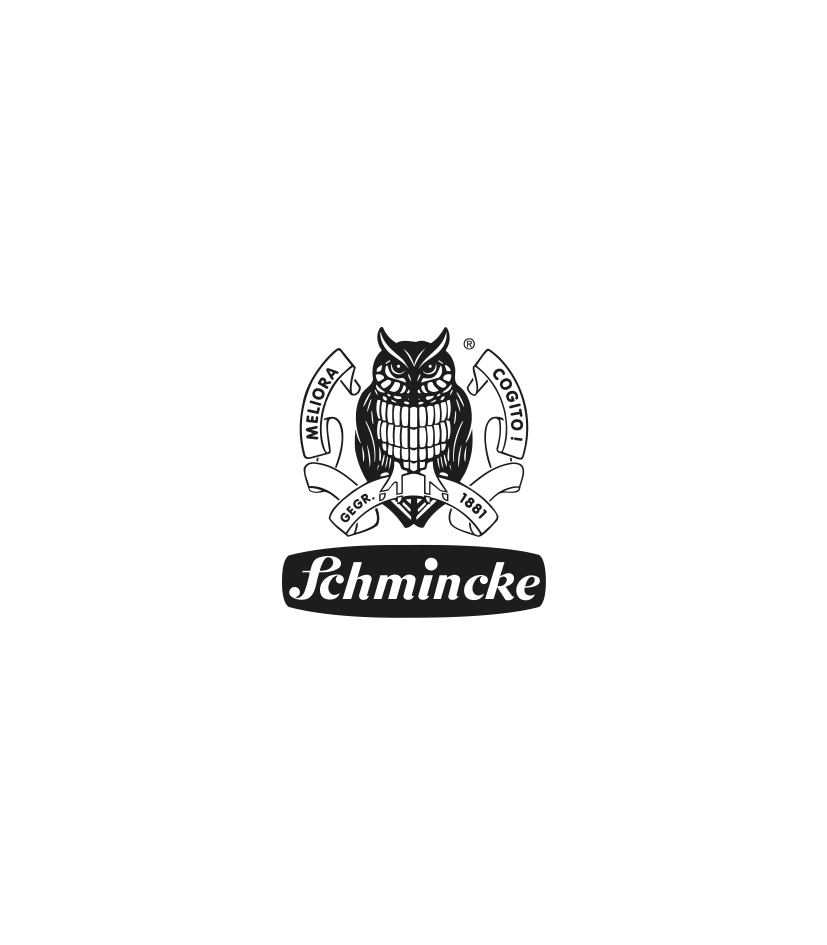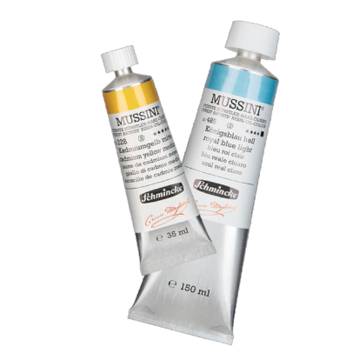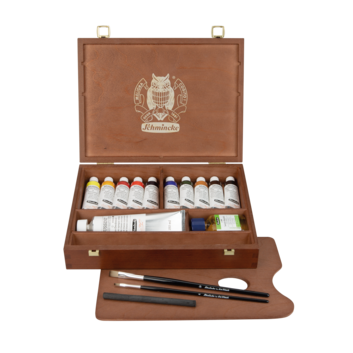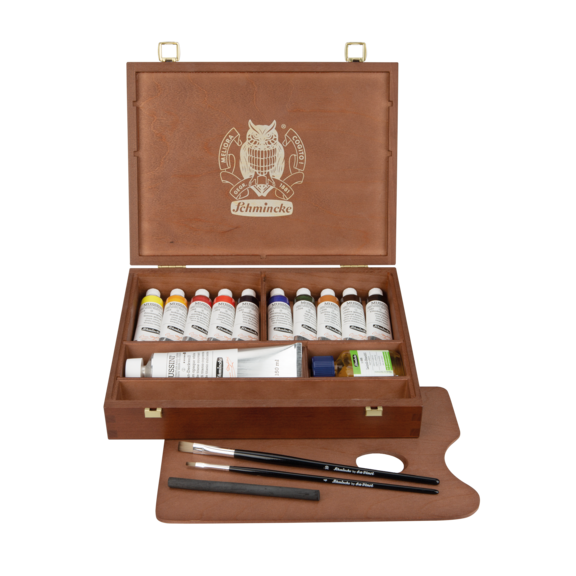MUSSINI – Finest artists’ resin-oil colours, series 10
- Worldwide unique
- 108 precious colours of the highest brilliance, including 60 single-pigment colours, 44 radiant transparent colours and some unique special colours
- Balanced and tension-free drying process
- Delicate resin scent
- Available in 108 colours in 35 ml tubes and 32 colours in 150 ml tubes
MUSSINI – Quality Since 1881
With the founding product of Schmincke dating back to 1881 oil painters have access to a unique resin-oil colour based on the recipes of the old masters. Offering a wide range of colours including a variety of colouristic treasures, balanced drying and a pleasant, delicately resinous scent, MUSSINI provides a finest resin-oil colour of the highest quality.
The recipes - A historical treasure
The recipes for MUSSINI colours are the result of the rich knowledge of professor Cesare Mussini, who once worked at the Academy of Fine Arts in Florence. Countless masterpieces bear witness of these colour advantages: radiant intensity, maximum lightfastness and a variety of transparent colours with special depth of light make MUSSINI a true treasure among artists’ colours.
The production - A select combination
While manufacturing MUSSINI colours Schmincke combines natural oils such as linseed oil, safflower oil and walnut oil with dissolved dammar natural resin. The addition of dammar resin is tailored to the individual needs of each colour to ensure a balanced recipe. This results in 108 colours, each with its own balanced composition.
Optimal compatibility with other oil colours
Despite the resin content MUSSINI is not a closed colour system. On the contrary these colours can also be effortlessly mixed and combined with oil colours without resin, without the need of additional media. Hence using existing colours and combining them with MUSSINI easily expands and enhances your own palette.
44 precious transparent colours and unique special shades
With the finest processing of precious transparent pigments Schmincke also offers an extensive range for the special technique of glaze painting. The 44 transparent colours including famous tones like Florentine Red or transparent Oriental Blue are characterised by the highest brilliance and luminosity as well as a unique, characteristic depth of light. The selection of other unique MUSSINI colours such as Caesar Purple, Atrament or Byzantine Blue are equally inspiring.
Harmonious drying
Thanks to the unique formula of MUSSINI the drying process occurs harmoniously and largely tension-free. While the chemically drying oils dry on the surface and absorb oxygen, the solvent content of the dammar natural resin evaporating from the inside balances out the increase in volume. This allows even drying in the deeper layers and on the surface of the colours.
Individual drying times
The drying time of a MUSSINI colour layer is as individual as the colours are themselves. It depends on various aspects including the type and quantity of oils and pigments used, the thickness of the paint layer and the drying temperature. To provide better guidance Schmincke has developed a Drying Time Scale (DTS) with three drying categories to assess the drying times of each colour more accurately and thus optimise the painting process.
The Drying Time Scale indicates how long it takes for a 30µm paint layer (equivalent to a thin brushstroke) of a colour to dry at room temperature (23°C). For thicker paint applications drying times will of corse be accordingly longer.
Trusted quality - carefully refined
Schmincke represents the highest quality and well-proven formulations that are appreciated by artists worldwide. Nevertheless, occasional adjustments may be necessary - whether due to the further development of our products or the availability of pigments and raw materials. Our claim remains unchanged: To continuously offer you the best artists' colours.
Information on current product adjustments are available here.
MUSSINI® - Farbkarten - Colour chart




Flake white subst. corresponds - to a large extent - optically and technically to the historical Flake white and shows a slightly warm, semi-opaque white tone. In addition to its pure use, for example in portrait painting, it is also used to lighten colours without significantly changing their colour character


Flake white subst. corresponds - to a large extent - optically and technically to the historical Flake white and shows a slightly warm, semi-opaque white tone. In addition to its pure use, for example in portrait painting, it is also used to lighten colours without significantly changing their colour character




Pure white, semi-opaque in relation to titanium white. Ideal for lightening multicoloured shades.


Pure white, semi-opaque in relation to titanium white. Ideal for lightening multicoloured shades.




Pure, brilliant white. Possesses the highest opacity and tinting power of all white colours.


Pure, brilliant white. Possesses the highest opacity and tinting power of all white colours.




Titanium white with ultrafine primary grain, providing a semi-transparenteffect. Forms fine white haze effects which display a milky blue shimmer in glancing light. An ideal colour to create atmospheric perspectives.


Titanium white with ultrafine primary grain, providing a semi-transparenteffect. Forms fine white haze effects which display a milky blue shimmer in glancing light. An ideal colour to create atmospheric perspectives.




Warm, reddish colour. Ideal base for mixing other shades for portrait painting.


Warm, reddish colour. Ideal base for mixing other shades for portrait painting.




Pale, greenish, opaque yellow which imitates the original with inorganic
pigments. Medieval yellow was the brightest yellow used by the Medieval
painters.


Pale, greenish, opaque yellow which imitates the original with inorganic
pigments. Medieval yellow was the brightest yellow used by the Medieval
painters.




Light, delicate greenish yellow which can hardly be obtained by mixing, made from inorganic pigments.


Light, delicate greenish yellow which can hardly be obtained by mixing, made from inorganic pigments.




mitation of cadmium yellow with inorganic pigment. High tinting power,
semi-opaque, cadmium-free.


mitation of cadmium yellow with inorganic pigment. High tinting power,
semi-opaque, cadmium-free.




Fine transparent, warm yellow, similar to the basic colour yellow.


Fine transparent, warm yellow, similar to the basic colour yellow.




The classic brilliant, green-tinged yellow in oil colouring. Mixes well with
transparent cyan; produces clear, semi-transparent green shades.


The classic brilliant, green-tinged yellow in oil colouring. Mixes well with
transparent cyan; produces clear, semi-transparent green shades.




Contains a modern, opaque pigment with high tinting power. Produces a brilliant, slightly green-tinted yellow. A cadmium-free alternative to cadmium yellow. Mixes
well with transparent cyan, produces clear, brilliant, opaque green shades.


Contains a modern, opaque pigment with high tinting power. Produces a brilliant, slightly green-tinted yellow. A cadmium-free alternative to cadmium yellow. Mixes
well with transparent cyan, produces clear, brilliant, opaque green shades.




Contains a modern, opaque pigment with high tinting power. Produces a
reddish, slightly dull yellow.


Contains a modern, opaque pigment with high tinting power. Produces a
reddish, slightly dull yellow.




n former times, Indian yellow was produced in India from the urine of cows which were fed with mango leaves. This method of production is prohibited today, because it is cruel. Our Indian yellow is an imitation of the classic transparent orange-yellow colour.


n former times, Indian yellow was produced in India from the urine of cows which were fed with mango leaves. This method of production is prohibited today, because it is cruel. Our Indian yellow is an imitation of the classic transparent orange-yellow colour.




Traditional colour produced from inorganic pigments. Very light, almost beige yellow.


Traditional colour produced from inorganic pigments. Very light, almost beige yellow.




Brilliant opaque yellow with high tinting power.


Brilliant opaque yellow with high tinting power.




Rich, red-tinted yellow with good opacity and tinting power.


Rich, red-tinted yellow with good opacity and tinting power.




Brilliant yellow-orange with high opacity and tinting power.


Brilliant yellow-orange with high opacity and tinting power.




Brilliant orange with high opacity and tinting power.


Brilliant orange with high opacity and tinting power.




The lighter and yellow variant of dark Naples yellow.


The lighter and yellow variant of dark Naples yellow.




Warm, opaque, almost ochre-coloured yellow. Previously produced from toxic lead pigment, now an imitation with inorganic, highly lightfast pigments.


Warm, opaque, almost ochre-coloured yellow. Previously produced from toxic lead pigment, now an imitation with inorganic, highly lightfast pigments.




Inorganic yellow which produces a very fine glaze effect; the tone is roughly similar to a brilliant yellow ochre or a very yellow Sienna


Inorganic yellow which produces a very fine glaze effect; the tone is roughly similar to a brilliant yellow ochre or a very yellow Sienna




Warm, finely transparent brownish orange.


Warm, finely transparent brownish orange.




Lemon yellow when applied in a thin layer to produce a fine glaze. Dark, almost ochre-coloured yellow when applied as an opaque layer.


Lemon yellow when applied in a thin layer to produce a fine glaze. Dark, almost ochre-coloured yellow when applied as an opaque layer.




Finely transparent dark orange shade with pronounced red tinge. Ideal for mixing to produce very light red shades.


Finely transparent dark orange shade with pronounced red tinge. Ideal for mixing to produce very light red shades.




Imitation of the toxic chrome orange with a non-toxic, modern, opaque organic pigment with high tinting power. A very deep, brilliantly fiery orange.


Imitation of the toxic chrome orange with a non-toxic, modern, opaque organic pigment with high tinting power. A very deep, brilliantly fiery orange.




In former times, scarlet was a much sought-after colour which was obtained from a coccid which lives in the Kermes oak. Today, the name “scarlet” is given to a brilliant red with a very pronounced yellow tinge.


In former times, scarlet was a much sought-after colour which was obtained from a coccid which lives in the Kermes oak. Today, the name “scarlet” is given to a brilliant red with a very pronounced yellow tinge.




Rich opaque red with high tinting power. Darker and bluer than light cadmium red.


Rich opaque red with high tinting power. Darker and bluer than light cadmium red.




Finely transparent dark, brownish red. Comparable with very red mahogany.


Finely transparent dark, brownish red. Comparable with very red mahogany.




Transparent, very bright deep red. With the exception of “Alizarin madder lake”, ourMUSSINI “madder” colours are standard tone designations. They are simulated today with highly light-fast, transparent, modern organic pigments.


Transparent, very bright deep red. With the exception of “Alizarin madder lake”, ourMUSSINI “madder” colours are standard tone designations. They are simulated today with highly light-fast, transparent, modern organic pigments.




Brilliant dark red with a blue tinge. Lighter than alizarin madder lake, produces a good glaze effect.


Brilliant dark red with a blue tinge. Lighter than alizarin madder lake, produces a good glaze effect.




Cold, rich dark red, produces good glaze effects. Originally an alumina-based colour from alizarin, the main dyestuff contained in the madder plant. Since 1870, alizarin has been obtained and processed into colour by synthetic means.


Cold, rich dark red, produces good glaze effects. Originally an alumina-based colour from alizarin, the main dyestuff contained in the madder plant. Since 1870, alizarin has been obtained and processed into colour by synthetic means.




Perylenes are among the most lightfast organic pigments. A transparent, cold, dark red with a slight brown tint. Florentine red is based on the old Florentine colour which was obtained from Brazil wood and was similar in colour.


Perylenes are among the most lightfast organic pigments. A transparent, cold, dark red with a slight brown tint. Florentine red is based on the old Florentine colour which was obtained from Brazil wood and was similar in colour.




Pure opaque red with high tinting power. Similar to vermilion red.


Pure opaque red with high tinting power. Similar to vermilion red.




Very deep red with a blue tinge. High opacity and tinting power.


Very deep red with a blue tinge. High opacity and tinting power.




A standard tone designation, derived directly from the Latin name for the cocchineal louse. Brilliant red with blue tinge, semi-transparent.


A standard tone designation, derived directly from the Latin name for the cocchineal louse. Brilliant red with blue tinge, semi-transparent.




Corresponds to the basic colour magenta in subtractive colour mixture, produces a very good glaze effect. Produces brilliant, transparent violet shades when mixed with transparent cyan.


Corresponds to the basic colour magenta in subtractive colour mixture, produces a very good glaze effect. Produces brilliant, transparent violet shades when mixed with transparent cyan.




Classic red. As real cinnabar is toxic and possesses poor lightfastness, this colour has been imitated with a modern, organic pigment. Brilliant, opaque red, bluer than scarlet, yellower than carmine


Classic red. As real cinnabar is toxic and possesses poor lightfastness, this colour has been imitated with a modern, organic pigment. Brilliant, opaque red, bluer than scarlet, yellower than carmine




Warm, finely transparent reddish brown, commonly used today to imitate burnt Sienna


Warm, finely transparent reddish brown, commonly used today to imitate burnt Sienna




Finely transparent colour, bluer than transparent magenta. In ancient times, purple was obtained by means of a complicated process from the gland of a snail, and was much sought-after as a particularly valuable dye for artists’ colours


Finely transparent colour, bluer than transparent magenta. In ancient times, purple was obtained by means of a complicated process from the gland of a snail, and was much sought-after as a particularly valuable dye for artists’ colours




Lightfast, delicate, brilliant, and semi-opaque red violet.


Lightfast, delicate, brilliant, and semi-opaque red violet.




Very finely transparent, brilliant bluish violet with particularly high tinting power


Very finely transparent, brilliant bluish violet with particularly high tinting power




Semi-opaque cobalt blue shade with a greenish tendency


Semi-opaque cobalt blue shade with a greenish tendency




Corresponds to the basic colour cyan in the subtractive colour mixture; very goodglaze effect. Produces brilliant, transparent violet shades when mixed with magenta and brilliant, semi-transparent green shades when mixed with lemon yellow.


Corresponds to the basic colour cyan in the subtractive colour mixture; very goodglaze effect. Produces brilliant, transparent violet shades when mixed with magenta and brilliant, semi-transparent green shades when mixed with lemon yellow.




Deep blue with very high tinting power. This colour used to be obtained from the indigo plant or woad; today, indigo is produced by synthetic means


Deep blue with very high tinting power. This colour used to be obtained from the indigo plant or woad; today, indigo is produced by synthetic means




Imitation of cobalt blue deep with ultramarine. Opaque, with high tinting power, slightly greener and duller.


Imitation of cobalt blue deep with ultramarine. Opaque, with high tinting power, slightly greener and duller.




Semi-opaque, clear blue with a slight red tinge.


Semi-opaque, clear blue with a slight red tinge.




Semi-opaque blue with a subtle red tinge. Genuine cobalt blue was discovered in the 18th century, and was first used in colouring at the beginning of the 19th century. With cobalt blue, it was now possible to colour a radiant blue sky.


Semi-opaque blue with a subtle red tinge. Genuine cobalt blue was discovered in the 18th century, and was first used in colouring at the beginning of the 19th century. With cobalt blue, it was now possible to colour a radiant blue sky.




The classical royal blue was introduced under King Louis XIV of France, based on a cobalt pigment. The king’s blue was light, corresponding roughly to a green-tinged sky blue, similar to our royal blue light.


The classical royal blue was introduced under King Louis XIV of France, based on a cobalt pigment. The king’s blue was light, corresponding roughly to a green-tinged sky blue, similar to our royal blue light.




The possibility of producing ultramarine synthetically led to an increase in variations of the royal blue colour. Deep royal blue is a brilliant medium blue produced with ultramarine.


The possibility of producing ultramarine synthetically led to an increase in variations of the royal blue colour. Deep royal blue is a brilliant medium blue produced with ultramarine.




Brilliant, semi-transparent blue with a turquoise tinge. An imitation of toxic manganese blue using the non-toxic organic phthalocyanine pigments.


Brilliant, semi-transparent blue with a turquoise tinge. An imitation of toxic manganese blue using the non-toxic organic phthalocyanine pigments.




Traditional colour. Black blue with very high tinting power. Its real shade is only revealed in glazes. Has a tendency towards bronzing on account of its high pigmentation.


Traditional colour. Black blue with very high tinting power. Its real shade is only revealed in glazes. Has a tendency towards bronzing on account of its high pigmentation.




Lighter than dark ultramarine and with a slightly less pronounced red tinge


Lighter than dark ultramarine and with a slightly less pronounced red tinge




Finely transparent, very pure blue with a red tinge. In the Middle Ages, ultramarinewas obtained from the semi-precious stone lapis lazuli. Not until the first third of the 19th century was it possible to produce ultramarine by synthetic means.


Finely transparent, very pure blue with a red tinge. In the Middle Ages, ultramarinewas obtained from the semi-precious stone lapis lazuli. Not until the first third of the 19th century was it possible to produce ultramarine by synthetic means.










Imitation of indigo with very high tinting power and improved lightfastness. Also comparable to midnight blue on account of its depth of colour.


Imitation of indigo with very high tinting power and improved lightfastness. Also comparable to midnight blue on account of its depth of colour.




Dark black blue which retains its blue character. Often appears in Byzantine frescos. In former times it was obtained primarily from azurite and a small fraction of coal. Composition of modern, lightfast pigments.


Dark black blue which retains its blue character. Often appears in Byzantine frescos. In former times it was obtained primarily from azurite and a small fraction of coal. Composition of modern, lightfast pigments.




Finely transparent, brilliant deep blue, the phthalocyanine pigment with the most pronounced red tint. These pigments were discovered in the 1920s and are now one of the most important and most stable organic pigments .


Finely transparent, brilliant deep blue, the phthalocyanine pigment with the most pronounced red tint. These pigments were discovered in the 1920s and are now one of the most important and most stable organic pigments .




Very finely transparent, brilliant turquoise blue; the phthalocyanine pigment with the most pronounced green tinge.


Very finely transparent, brilliant turquoise blue; the phthalocyanine pigment with the most pronounced green tinge.




Opaque, highly lightfast turquoise with high tinting power and extreme brilliance of colour.


Opaque, highly lightfast turquoise with high tinting power and extreme brilliance of colour.




Opaque, light and pure green with very high tinting power.


Opaque, light and pure green with very high tinting power.




Opaque, deep and pure bluish green with very high tinting power.


Opaque, deep and pure bluish green with very high tinting power.




Fiery, semi-transparent green with a blue tinge, also commonly referred to as emerald green. This colour has been available to artists since the mid-19th century, when it replaced the copper colours which were toxic at the time


Fiery, semi-transparent green with a blue tinge, also commonly referred to as emerald green. This colour has been available to artists since the mid-19th century, when it replaced the copper colours which were toxic at the time




Dull, olive-tinged, highly stable green, with high tinting power and opacity.


Dull, olive-tinged, highly stable green, with high tinting power and opacity.




Finely transparent, brilliant, blue-tinged, rich green which cannot be produced by mixing.


Finely transparent, brilliant, blue-tinged, rich green which cannot be produced by mixing.




Lighter variation with a more pronounced yellow tinge than helio green deep.


Lighter variation with a more pronounced yellow tinge than helio green deep.




Dark green with good glaze effect. Similar to Dutch pink, which was obtained from the unripe berries of the milkwort


Dark green with good glaze effect. Similar to Dutch pink, which was obtained from the unripe berries of the milkwort




Brilliant light green with high opacity, produced from two “pure” pigments.


Brilliant light green with high opacity, produced from two “pure” pigments.




Semi-transparent, gentle, yellow-tinged green, very similar to the “original” Schweinfurt green. Schweinfurt green was an important artists’ colour in the 19th century, but was highly toxic on account of its arsenic content


Semi-transparent, gentle, yellow-tinged green, very similar to the “original” Schweinfurt green. Schweinfurt green was an important artists’ colour in the 19th century, but was highly toxic on account of its arsenic content










Golden-toned in glazes, like a light, yellowish sap green in full tone


Golden-toned in glazes, like a light, yellowish sap green in full tone










Dark, rich bluish green, similar to the semi-precious stone tourmaline, whose shades range from yellowish green and olive green to bluish green


Dark, rich bluish green, similar to the semi-precious stone tourmaline, whose shades range from yellowish green and olive green to bluish green




Imitation of the prime Terra Verde earths from Baldo near Verona, which are no longer available. Ideal for producing the “Verdaccio” effect, the green priming coat applied to the main areas in portrait colouring.


Imitation of the prime Terra Verde earths from Baldo near Verona, which are no longer available. Ideal for producing the “Verdaccio” effect, the green priming coat applied to the main areas in portrait colouring.




Imitation of the particularly brilliant Sienna earths, which are virtually unobtainable today, with selected ferrous oxides


Imitation of the particularly brilliant Sienna earths, which are virtually unobtainable today, with selected ferrous oxides




Highly stable pigments are used to imitate the asphalt colour which was widespread in the 19th century, a transparent, deep brown of low stability which was able to show through the colour layers.


Highly stable pigments are used to imitate the asphalt colour which was widespread in the 19th century, a transparent, deep brown of low stability which was able to show through the colour layers.




Natural earth with a highly pronounced brown tinge, low tinting power. Results from the weathering of calcium-magnesium-iron-silicates.


Natural earth with a highly pronounced brown tinge, low tinting power. Results from the weathering of calcium-magnesium-iron-silicates.




This warm, brownish red was found on the mural colourings in Pompeii. It is darker than Pozzuoli earth.


This warm, brownish red was found on the mural colourings in Pompeii. It is darker than Pozzuoli earth.




Violet-tinged dark reddish brown with high opacity and tinting power. Its name is derived from the field of alchemy and means “death’s head”, as this colour was obtained from iron salts which were baked down to their “dying” embers.


Violet-tinged dark reddish brown with high opacity and tinting power. Its name is derived from the field of alchemy and means “death’s head”, as this colour was obtained from iron salts which were baked down to their “dying” embers.




Generic name for light iron oxide reds, brownish red with high opacity and tinting power


Generic name for light iron oxide reds, brownish red with high opacity and tinting power




Dark, warm, red-tinged ochre pigmented with a natural earth from Germany.


Dark, warm, red-tinged ochre pigmented with a natural earth from Germany.




Imitation of the ochre which was much sought-after in ancient times, usingmodern ferrous oxides. Semi-opaque to semi-transparent. Fiery golden yellow in glazes


Imitation of the ochre which was much sought-after in ancient times, usingmodern ferrous oxides. Semi-opaque to semi-transparent. Fiery golden yellow in glazes




Semi-transparent to semi-opaque ochre yellow pigmented with a natural earth from Germany.


Semi-transparent to semi-opaque ochre yellow pigmented with a natural earth from Germany.




Dark reddish brown, semi-transparent to semi-opaque, pigmented with a burnt natural earth.


Dark reddish brown, semi-transparent to semi-opaque, pigmented with a burnt natural earth.




Stil de grain was formerly obtained from the dyestuff contained in the semi-ripe berries of the milkwort – a warm transparent tone.


Stil de grain was formerly obtained from the dyestuff contained in the semi-ripe berries of the milkwort – a warm transparent tone.




Imitation of the famous natural earths from Italy, which are barely obtainable today. Its name relates to the place where it was formerly found at the foot of Vesuvius. Slightly lighter and yellower than Pompeiian red, with high opacity and tinting power.


Imitation of the famous natural earths from Italy, which are barely obtainable today. Its name relates to the place where it was formerly found at the foot of Vesuvius. Slightly lighter and yellower than Pompeiian red, with high opacity and tinting power.




Mixture of natural earths and organic pigments. Semi-transparent, dark, olive-tinged brown


Mixture of natural earths and organic pigments. Semi-transparent, dark, olive-tinged brown




Pigmented with a natural earth. When burned, the umbers lose water of crystallisation and their grain size increases. This results in increased opacity and a shift in the shade towards a deep reddish brown with high tinting power.


Pigmented with a natural earth. When burned, the umbers lose water of crystallisation and their grain size increases. This results in increased opacity and a shift in the shade towards a deep reddish brown with high tinting power.




Imitation of the colour which was formerly obtained from fine-washedbrown coal, using highly stable pigments. The original colour was similarly unstable to asphalt. A transparent, deep blackish brown.


Imitation of the colour which was formerly obtained from fine-washedbrown coal, using highly stable pigments. The original colour was similarly unstable to asphalt. A transparent, deep blackish brown.




Dark, finely transparent reddish brown with high tinting power, more fiery than Vandyke brown.


Dark, finely transparent reddish brown with high tinting power, more fiery than Vandyke brown.




Pigmented with a natural earth. Very fiery and yellow-tinged when used for glazing.


Pigmented with a natural earth. Very fiery and yellow-tinged when used for glazing.




Modern organic black pigment. Very deep in full tone, close to a Russian green in glazes. Produces green-tinged grey tones when mixed with white. Atrament was the name for a very cold black in Roman times.


Modern organic black pigment. Very deep in full tone, close to a Russian green in glazes. Produces green-tinged grey tones when mixed with white. Atrament was the name for a very cold black in Roman times.




Traditional deep black, opaque and lightfast. Formerly obtained from charred ivory pieces, now produced via the dry distillation of degreased bones


Traditional deep black, opaque and lightfast. Formerly obtained from charred ivory pieces, now produced via the dry distillation of degreased bones




Particularly fine gas black with maximum depth of colour. This provides for high intensity and tinting power


Particularly fine gas black with maximum depth of colour. This provides for high intensity and tinting power




Traditional Schmincke grey colour. Very similar to a dark neutral grey.


Traditional Schmincke grey colour. Very similar to a dark neutral grey.




"Cool”, inorganic black with a gentle tinge of charcoal. Produces a blue- tinged grey when mixed with white.


"Cool”, inorganic black with a gentle tinge of charcoal. Produces a blue- tinged grey when mixed with white.




Light stone grey, a “neutral” grey for the beholder.


Light stone grey, a “neutral” grey for the beholder.










Opaque grey with delicate red tinge, without black pigments


Opaque grey with delicate red tinge, without black pigments




Semi-opaque grey with green tinge, without black pigment.


Semi-opaque grey with green tinge, without black pigment.




Greenish, semi-transparent grey. Specially developed to produce the Italian masters’ famous “sfumato” – a fine grey mist which was applied to portraits, for example, in order to lend them a softer look


Greenish, semi-transparent grey. Specially developed to produce the Italian masters’ famous “sfumato” – a fine grey mist which was applied to portraits, for example, in order to lend them a softer look
















Highly opaque yellow warm gold shade, genuine bronze pigment.


Highly opaque yellow warm gold shade, genuine bronze pigment.




Highly opaque greenish gold shade, genuine bronze pigment.


Highly opaque greenish gold shade, genuine bronze pigment.




Highly opaque deep yellow gold shade, genuine bronze pigments


Highly opaque deep yellow gold shade, genuine bronze pigments




Highly opaque brownish gold shade, genuine bronze pigments


Highly opaque brownish gold shade, genuine bronze pigments




Highly opaque slightly reddish gold shade, genuine bronze pigments.


Highly opaque slightly reddish gold shade, genuine bronze pigments.






Videos









